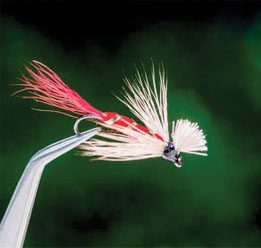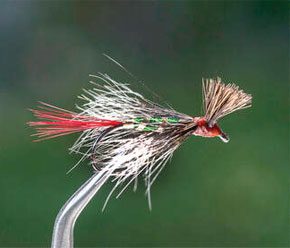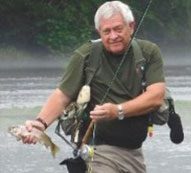
By Tom Adams, Alen Baker
www.rockyrivertu.org/dry-fly-patterns.html
Contrary to the superstition that Eskimos might have been the first to use Polar bear hair on hooks to catch “hewluk-powak,” meaning “fish with wing like fin” or the artic grayling, or any other fish, they did not, for they never used anything but bait. The first known use of Polar bear hair for fly tying was in 1923 when T.V. Sandys-Wunsch,of the Royal Canadian Mounted Police,and F. A. Ashton,of Vancouver, Can-ada,used Polar bear flies made from a skin brought out of the North by Wunsch. By 1925, Polar bear hair flies were sold commercially by Harkley & Hayward of Vancouver, Canada.Ken Cooper of Detroit, Michigan,brought polar bear hair flies to the attention of fly fishers in the States. Ken, making no claim as the originator said, “I was working for Lou J. Eppinger in 1932 and used to prowl around the taxidermy shop, looking for fur or feathers to make flies. They had a mounted Polar bear that had outlived its usefulness. It was a sorry sight and I said to the taxidermist, ‘Why don’t you throw it out?’ and he said, ‘I would like to, but the boss thinks we should save it.’ So, I asked Lou how much he thought it was worth. He smiled and said, ‘Do you want it for fly tying material? Well, help yourself.’

I walked into the taxidermy shop and cut about a yard of hide off that bear, told the taxidermist to wash it, cut it up in small pieces, put it in the tumbling barrel with some hard wood sawdust and do a good job, and we would soon be rid of that bear. I tied up some Polar bear flies for the store and sold the balance of the bear hide for fly tying. It did not last long.”Ken Cooper,who created the Cooper Bug,later becamewell known for his Polar bear flies. Cato Holler,who lived on Armstrong Creek near Marion, North Carolina,shot his Polar bear in the early 1970s prior to the time it became illegal to harvest a polar bear. Cato developednumerous Southern Appalachian vari-ations of flies using dyed Polar bear hair. A few of his flies are on display at the Fly Fishing Museum of the Southern Appalachians. Although Polar bear hair was already popular in Canada, it had not been used in the States before Ken Cooper blazed the trail.There is a trout fly called the Cooper wet fly that was originated by George T. Cooper who was appointed on the New York Fish Commission in 1869 in Seth Green’s place, when Mr. Green resigned to take charge of the Caledonia Hatchery. The Cooper wetfly has an orange body,black hackle,and brown tur-key wing. This article is not to be confused with, nor it isabout,the Cooper wet fly pattern.

Credits: Quotes and drawing from Fly Pattern and Their Origins (1944, 1950), by Harold Hinsdill Smed-ley, Westshore Publications, Muskegon, Michigan. Colored photo from Ray Bergman’s Trout.
The originator of the Cooper Bug, Ken Cooper said, “This fly just happened. Bass fishing and bass flies do not intrigue me very greatly, but when I cannot fish for trout I do not scorn the bass or bluegill. They are an excuse to get out in the open, which always seems to give me a new lease on life.”
“In 1936, while preparing for a bass fishing trip, I put a hook in my fly-tying vise and tried to figure out what to tie on it to try out on this trip. A red tail seemed to be a good start, so I put on a red deer hair tail, then a red wool body with a gold rib, next a bunch of deer hair. I divided it to make wings at right angles to the hook. This gave me a fly that would look reasonably large but be light in weight, also lift and handle nicely with a bass fly rod. The butt of the deer hair blossomed out into quite a topknot but instead of cutting it off, it was tied to stand upright and was cut flat across the top leaving a V-shaped topknot about five-eighths of an inch high. The finished fly was tossed into the air a few times to see how it would land and much to my surprise it always landed right side up, the V top acting as a parachute.”
“This was something different. I selected Pine Lake, a hard-fished body of water, for the try-out. It was a beautiful moonlight night and I fished alone and fished all night. The bass seemed to like this bug and so did I, as the topknot gave it good visibility.”

“I gave one of these bugs to Al Hilde, a brother-in-law of Paul Young of Detroit, Michigan, to try out and asked him to suggest a name. He said it looked like a French poodle that had been sheared and suggested the name Poodle Bug and thus was it born and named.”
“In 1938 Ray Bergman came out with a book called Trout. While he was gathering materials for his book. Phil Armstrong thought he should have one of my flies and I gave Phil a Poodle Bug, which he personally delivered to Berg-man. Phil thought he could improve on the name of the fly, so he told Bergman the name was the Cooper Bug. On color plate number 15 in Bergman’s book there is a picture of this fly and it is called a Cooper Bug.”

Cooper Bug – Rocky River – Fly of the Month 7.19
Hook: Wet, 2xL
Size: 10, 12, 14
Thread: 6/0 Red
Tail: Red deer hair
Body: Color dubbing, your choice
Rib: Silver tinsel
Wing: Deer hair, may be tied as an overbody (alternate)
Head: Deer hair stub
Directions:
Detailed tying steps may be found at the Rocky River Chapter of Trout Unlimited at www.rockyrivertu.org/dry-fly-patterns.html